机器学习项目:使用Python进行零售价格推荐

日本最大的社区购物应用Mercari遇到了一个问题。他们希望向卖家提供定价建议,但这很难,因为他们的卖家能够在Mercari上放置任何东西。
在这个机器学习项目中,我们将建立一个自动建议正确的产品价格的模型。我们提供以下信息:
train_id - 列表的ID
name - 列表的标题
item_condition_id - 卖方提供商品的情况
category_name - 种类的列表
brand_name - 品牌名称
price - 该商品的售价。也就是我们预测的目标变量
shipping - 如果运费由卖方支付,买方支付0
item_description - 商品的完整描述
EDA
数据集可以从Kaggle下载(文末链接)。为了验证结果,我只需要train.tsv。让我们开始吧!
import gc
import time
import numpy as np
import pandas as pd
import matplotlib.pyplot as plt
import seaborn as sns
from scipy.sparse import csr_matrix, hstack
from sklearn.feature_extraction.text import CountVectorizer, TfidfVectorizer
from sklearn.preprocessing import LabelBinarizer
from sklearn.model_selection import train_test_split, cross_val_score
from sklearn.metrics import mean_squared_error
import lightgbm as lgb
df = pd.read_csv('train.tsv', sep = '\t')
随机将数据拆分为训练集和测试集。我们只对EDA使用训练集。
msk = np.random.rand(len(df)) < 0.8
train = df[msk]
test = df[~msk]
train.shape, test.shape
((1185866, 8), (296669, 8))
train.head()

train.info()
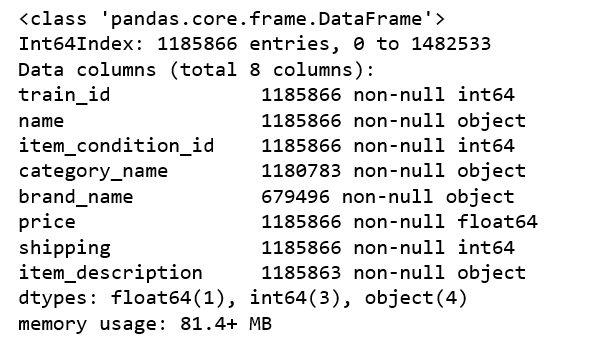
价格
train.price.describe()
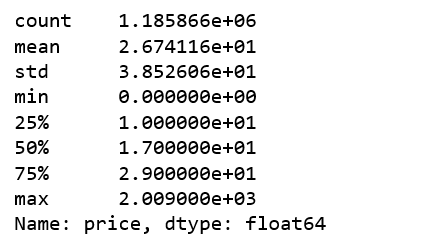
物品价格总体左倾(left skewed),绝大多数物品售价10-20。然而,最昂贵的商品定价在2009。所以我们会对价格进行对数变换。
plt.subplot(1,2,1)
(train ['price'])。plot.hist(bins = 50,figsize =(12,6),edgecolor ='white',range = [0,250])
plt .xlabel('price',fontsize = 12)
plt.title('Price Distribution',fontsize = 12)
plt.subplot(1,2,2)
np.log(train ['price'] + 1).plot.hist(bins = 50,figsize =(12,6),edgecolor ='white')
plt.xlabel( 'log(price + 1)',fontsize = 12)
plt.title('Price Distribution',fontsize = 12)
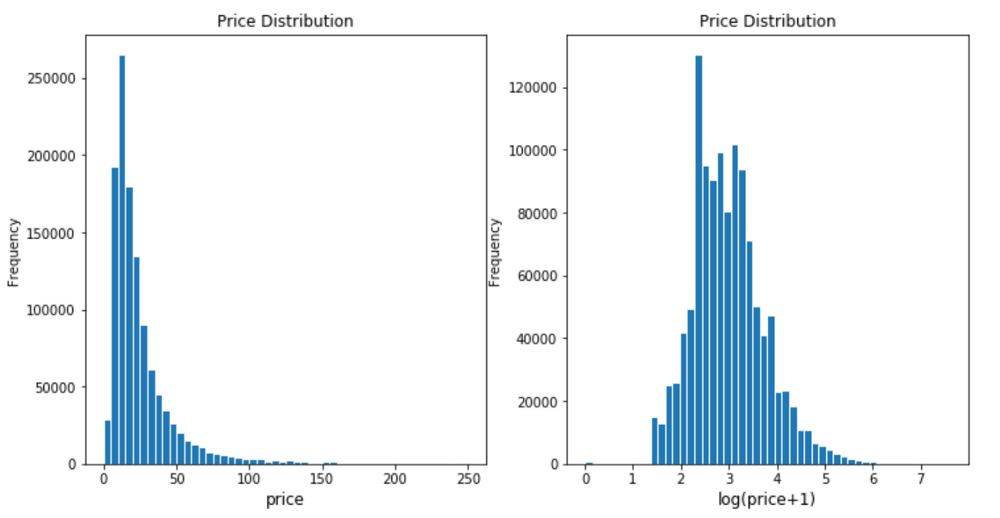
运费
超过55%的物品运费由买家支付。
train ['shipping']。value_counts()/ len(train)

运费如何与价格相关?
shipping_fee_by_buyer = train.loc[df['shipping'] == 0, 'price']
shipping_fee_by_seller = train.loc[df['shipping'] == 1, 'price']
fig, ax = plt.subplots(figsize=(18,8))
ax.hist(shipping_fee_by_seller, color='#8CB4E1', alpha=1.0, bins=50, range = [0, 100],
label='Price when Seller pays Shipping')
ax.hist(shipping_fee_by_buyer, color='#007D00', alpha=0.7, bins=50, range = [0, 100],
label='Price when Buyer pays Shipping')
plt.xlabel('price', fontsize=12)
plt.ylabel('frequency', fontsize=12)
plt.title('Price Distribution by Shipping Type', fontsize=15)
plt.tick_params(labelsize=12)
plt.legend()
plt.show()
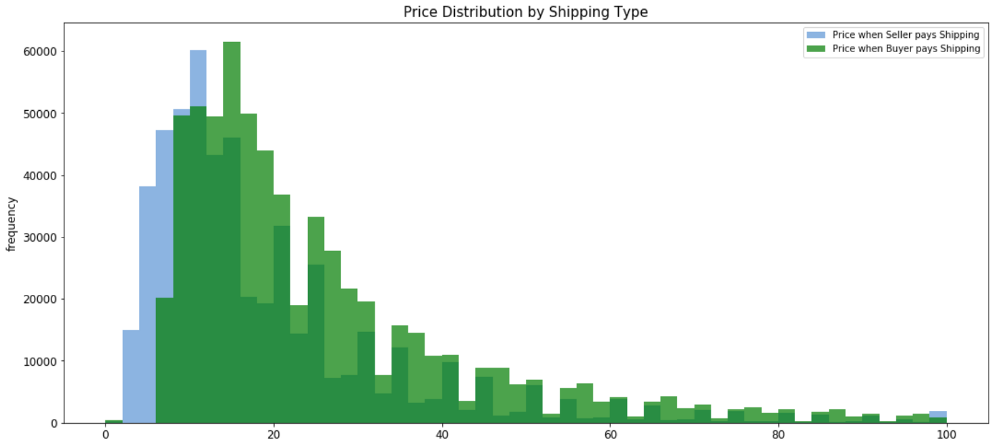
print('The average price is {}'.format(round(shipping_fee_by_seller.mean(), 2)), 'if seller pays shipping');
print('The average price is {}'.format(round(shipping_fee_by_buyer.mean(), 2)), 'if buyer pays shipping')如果卖家支付运费,平均价格为22.58
如果买家支付运费,平均价格为30.11
我们对价格进行对数转换后再次进行比较。
fig, ax = plt.subplots(figsize=(18,8))
ax.hist(np.log(shipping_fee_by_seller+1), color='#8CB4E1', alpha=1.0, bins=50,
label='Price when Seller pays Shipping')
ax.hist(np.log(shipping_fee_by_buyer+1), color='#007D00', alpha=0.7, bins=50,
label='Price when Buyer pays Shipping')
plt.xlabel('log(price+1)', fontsize=12)
plt.ylabel('frequency', fontsize=12)
plt.title('Price Distribution by Shipping Type', fontsize=15)
plt.tick_params(labelsize=12)
plt.legend()
plt.show()
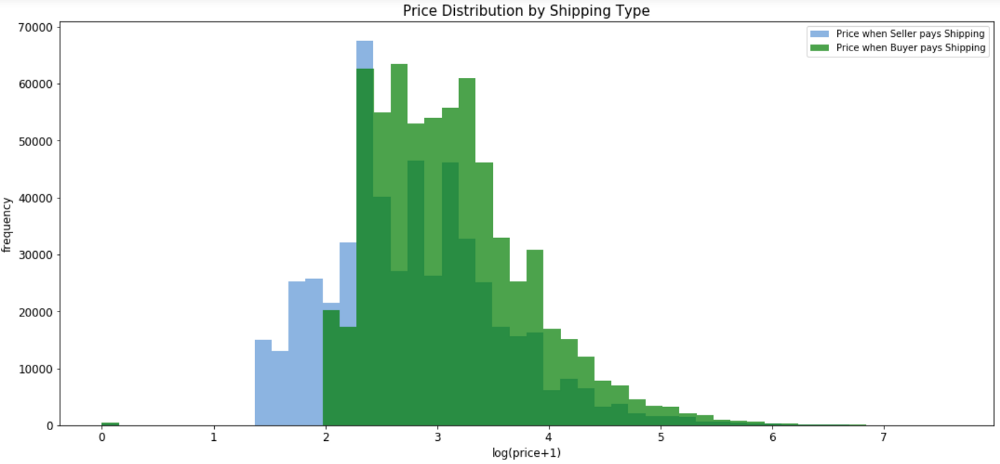
当买家支付运费时,平均价格显然会更高。
种类名称
print('There are', train['category_name'].nunique(), 'unique values in category name column')种类名称列中有1265个唯一值
十大最常见的种类名称:
train['category_name'].value_counts()[:10]

商品情况与价格
sns.boxplot(x ='item_condition_id',y = np.log(train ['price'] + 1),data = train,palette = sns.color_palette('RdBu',5))
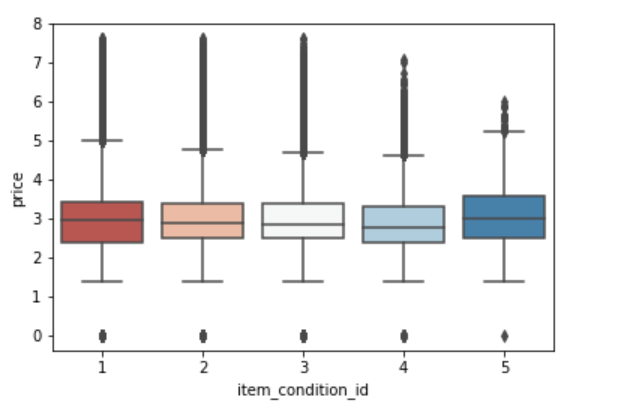
每个商品状态id的平均价格都不大一样。
经过以上的探索性数据分析,我决定使用所有的特征来构建我们的模型。
LightGBM
LightGBM是一个使用基于树的学习算法的梯度提升框架。具有它被设计成分布式且高效性的,它的优点包括:
- 更快的训练速度和更高的效率
- 更低的内存使用率
- 更高的准确性
- 支持并行和GPU学习
- 能够处理大规模数据
因此,我们要尝试一下。
常规设置:
NUM_BRANDS = 4000
NUM_CATEGORIES = 1000
NAME_MIN_DF = 10
MAX_FEATURES_ITEM_DESCRIPTION = 50000
我们必须修复的列中缺失值:
print('There are %d items that do not have a category name.' %train['category_name'].isnull().sum())有5083个商品没有种类名称。
print('There are %d items that do not have a brand name.' %train['brand_name'].isnull().sum())有506370个商品没有品牌名称。
print('There are %d items that do not have a description.' %train['item_description'].isnull().sum())有3个商品没有描述。
LightGBM的助手函数:
def handle_missing_inplace(dataset):
dataset['category_name'].fillna(value='missing', inplace=True)
dataset['brand_name'].fillna(value='missing', inplace=True)
dataset['item_description'].replace('No description yet,''missing', inplace=True)
dataset['item_description'].fillna(value='missing', inplace=True)
def cutting(dataset):
pop_brand = dataset['brand_name'].value_counts().loc[lambda x: x.index != 'missing'].index[:NUM_BRANDS]
dataset.loc[~dataset['brand_name'].isin(pop_brand), 'brand_name'] = 'missing'
pop_category = dataset['category_name'].value_counts().loc[lambda x: x.index != 'missing'].index[:NUM_CATEGORIES]
def to_categorical(dataset):
dataset['category_name'] = dataset['category_name'].astype('category')
dataset['brand_name'] = dataset['brand_name'].astype('category')
dataset['item_condition_id'] = dataset['item_condition_id'].astype('category')
删除price = 0的行
df = pd.read_csv('train.tsv',sep ='\ t')
msk = np.random.rand(len(df))<0.8
train = df [msk]
test = df [~msk]
test_new = test .drop('price',axis = 1)
y_test = np.log1p(test [“price”])
train = train [train.price!= 0] .reset_index(drop = True)
合并训练和新的测试数据。
nrow_train = train.shape [0]
y = np.log1p(train [“price”])
merge:pd.DataFrame = pd.concat([train,test_new])
训练准备
handle_missing_inplace(merge)
cutting(merge)
to_categorical(merge)
计算矢量化名称和种类名称的列。
cv = CountVectorizer(min_df = NAME_MIN_DF)
X_name = cv.fit_transform(merge ['name'])
cv = CountVectorizer()
X_category = cv.fit_transform(merge ['category_name'])
TF-IDF Vectorize item_description列。
tv = TfidfVectorizer(max_features = MAX_FEATURES_ITEM_DESCRIPTION,ngram_range =(1,3),stop_words ='english')
X_description = tv.fit_transform(merge ['item_description'])
标签二值化brand_name列。
lb = LabelBinarizer(sparse_output = True)
X_brand = lb.fit_transform(merge ['brand_name'])
为item_condition_id和运费列创建虚拟变量。
X_dummies = csr_matrix(pd.get_dummies(merge [['item_condition_id','shipping']],sparse = True).values)
创建稀疏合并。
sparse_merge = hstack((X_dummies,X_description,X_brand,X_category,X_name))。tocsr()
删除文档频率<= 1的特征。
mask = np.array(np.clip(sparse_merge.getnnz(axis = 0) -
1,0,1 ),dtype = bool)sparse_merge = sparse_merge [:,mask]
从稀疏合并中分离出训练和测试数据。
X = sparse_merge [:nrow_train]
X_test = sparse_merge [nrow_train:]
为lightgbm创建数据集。
train_X = lgb.Dataset(X,label = y)
将我们的参数指定为dict。
params = {
'learning_rate':0.75,
'application':'regression',
'max_depth':3,
'num_leaves':100,
'verbosity': - 1,
'metric':'RMSE',
}- 当我们处理回归问题时,使用“regression”作为应用程序。
- 使用“RMSE”作为度量,因为这是一个回归问题。
- “num_leaves”= 100,因为我们的数据相对较大。
- 使用“max_depth”以避免过拟合。
- 使用“verbosity”来控制LightGBM的冗余度(<0:致命)。
- “learning_rate”确定每棵树对最终结果的影响。
训练开始
训练模型需要参数列表和数据集。训练需要一段时间。
gbm = lgb.train(params,train_set = train_X,num_boost_round = 3200,verbose_eval = 100)
预测
y_pred = gbm.predict(X_test,num_iteration = gbm.best_iteration)
评估
from sklearn.metrics import mean_squared_error
print('The rmse of prediction is:', mean_squared_error(y_test, y_pred) ** 0.5)
预测的rmse是:0.46164222941613137
Kaggle:https://www.kaggle.com/tunguz/more-effective-ridge-lgbm-script-lb-0-44823
Github:https://github.com/susanli2016/Machine-Learning-with-Python/blob/master/Mercari%20Price%20Suggestion%20Lightgbm.ipynb
数据集:https://www.kaggle.com/saitosean/mercari































